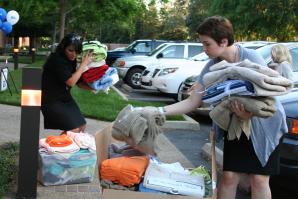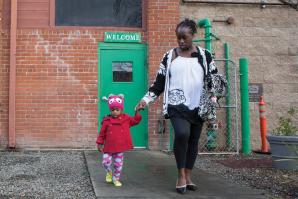Before the age of nine, Molly Carlson* had cycled through four foster homes. As one of three children born out of wedlock, each to different fathers, Molly was deeply affected by her mother’s meth addiction and neglect. She seemed stuck in an endless cycle of bad homes and careless providers. But that whole pattern changed when a court-appointed child advocate began petitioning the courts on Molly’s behalf. The result was adoption by a stable, permanent family. Three years later, Molly is a well-adjusted pre-teen, connected to her new family and excelling in school.
Over half a million kids live in foster care in the U.S. Like Molly, they end up there as a result of abuse, neglect or abandonment. Because they can’t advocate for themselves, many become victims a second time, lost in an overburdened child welfare system that can’t pay close attention to each child.
But one program is drastically improving outcomes for foster youth, despite the overwhelming odds.
The Court Appointed Special Advocates program was developed by Seattle juvenile court judge David Soukup in 1977. Tired of making drastic decisions with insufficient information when it came to foster youth, Soukup launched the CASA program to give children a voice and ensure their best interests were represented in court.
“The first time I sat in juvenile court, I had to make a tough decision regarding a 3-year-old little girl, with very little information,” Soukop recalls. “I looked around the courtroom and realized there was no one there whose only job was to investigate the case and tell me what was in the best interest of the child. It was like flying blind.”
So Soukop had his bailiff invite a few people to a brown bag lunch to talk about launching an advocacy program for kids. Word spread, and 50 people showed up. “That’s when I knew the program was going to work,” he says. “People cared. They just needed to know how to get involved.”
After retiring from the bench, Soukup became a CASA volunteer himself. “It is both the hardest and most satisfying thing I have ever done,” he says.
Statistically, the figures for foster youth are staggering. Data show one in five kids will age out of foster care, only to become homeless and alone. Of that 20 percent, roughly half will be homeless within 18 months. They are twice as likely as their peers to drop out of school, have mental health problems and become involved with substance abuse or the criminal justice system. A full 70 percent of the California prison population has been in foster care.
And the costs are just as shocking. On average, it takes $5,000 a month to house and feed a foster child. Reducing the amount of time each child spends in foster care by just one month would save the nation more than $2 billion a year.
“This is really the civil rights issue of our time,” says John Adams, executive director for Child Advocates of El Dorado County. “The impact of kids in long-term foster care is something that we as a society pay for well into the future.”
Comprised entirely of community volunteers appointed by judges, CASA has grown to a network of more than 950 programs that recruit, train and support volunteers in all 50 states. According to studies by the Department of Justice, CASA programs are reducing by half the number of children in long-term foster care and the number who end up back in the child welfare system.
“Studies have shown that the No. 1 path for building resiliency in a child who has faced repeated trauma is relationships,” says Tracy Fauver, executive director for Court Appointed Special Advocates of Yolo County.
The majority of the advocate’s hours are spent building relationships with the children they’re advocating for, doing background research and relaying those findings to the judge.
CASA volunteer Art Lyon is one of the few male advocates working in the program; about three-quarters are women. In a little over three years, he’s advocated for four children, some of them simultaneously. “In addition to helping these kids, my goal is to get more men to volunteer and be that positive, male role model these boys so desperately need,” he says.
He saw what a difference that can make when he was assigned to 14-year-old Josh*, who had been severely physically abused by his stepfather, was failing in school and was angry with his mom for her lack of protection. Lyon began to work with Josh, encouraging and reaffirming him.
“When I first met Art, I thought he was just another social worker, and I was not a big fan,” Josh says. “I was actually kind of rude to him and was pretty stubborn. But I learned to trust him pretty fast. He just let me vent, and I got to say what I wanted.”
After getting kicked off the high school football team for failing grades, Josh needed to make a change. Working with Lyon, he slowly began to settle down. His grades improved and the coach reinstated him. He’s started making plans for the future and envisions himself becoming a nurse, like his mom.
“Nursing jobs are always in demand, and it seems like it would be a cool job to have,” he says. “I have all the motivators I need to keep going, like my mom and Art, who will be there for me.”
In the Capital Region alone, there are 4,500 foster kids and four CASA programs serving them in Sacramento, Placer, El Dorado and Yolo counties. Most were started in the 1990s by former judges or community volunteers who saw how well the program worked in other areas.
“The CASA program is an invaluable resource that we rely on heavily when making decisions for juvenile youth,” says Stacy Boulware Eurie, a presiding judge of the Sacramento Juvenile Court who has been involved with the CASA program since 2010. “We always appreciate receiving a case with a CASA because we know an advocate is personally looking out for the best interests of that specific child.”
Nationally, CASA has an annual volunteer retention rate of 75 percent, but only 5 percent of children in foster care are represented by an advocate. In California, the child representation numbers improve to 20 percent, but the hurdles to cultivating volunteers are large and include a lack of funding, extensive training and commitment requirements, and insufficient marketing and public awareness.
To help quantify the impact CASA programs are making and justify the need for more funding and volunteers, California CASA, the state child advocacy organization, has launched a pilot program with several counties, including Placer and Sacramento. Each month, volunteers who are part of the pilot report back on how they are doing with their CASA kids in six main areas: physical and mental health, education, well-being, independent living, permanency and placement. The program was launched six months ago, and Cal CASA hopes to roll it out statewide in 2015.
Getting the word out is important for attracting a steady stream of volunteers, but budgets are limited. El Dorado County, for example, serves about 350 kids a year with a staff of six on an annual budget of just $500,000. As independent nonprofits, most CASA programs are primarily funded by their communities through donations, sponsorships, fundraising and grants. Some funding also comes from an agreement with the Administrative Office of the Court.
“We don’t have the budget we need to support a robust marketing program,” Adams says, “so we rely on other options,” like presentations to service organizations and churches. Child advocates and staff members also contribute articles to the local paper, post on Craigslist, use social media and canvas neighborhood businesses with flyers. At least half of all CASA volunteers come from referrals of existing advocates.
“On average, we have found that it takes between five and seven years from the time a person first hears about CASA to when they actually sign up to volunteer,” Adams says. “So the promotion cycle can be long, but it’s important to keep getting out there.”
Within weeks of being sworn in as a Sacramento County CASA, Donielle Prince was assigned to 15-year-old Jasmine*, a high-school freshman. “There was significant neglect, and her mother refused to take parenting classes,” Prince says. “Once she was removed from her home, she felt like she had no control over where she lived.” The revolving door of foster care with temporary living arrangements was stressful for Jasmine. “I could see that my relationship with her was important, especially for her to experience some kind of continuity,” Prince says.
Every week for a year, Prince drove Jasmine to her independent living classes. “Helping her successfully transition to adulthood is important,” Prince says. In June, Jasmine graduated from high school and enrolled in a local community college. She’s taking advantage of a new law that allows foster youth to remain in the system and receive resources and support until their 21st birthday.
“These next two years are critical for Jasmine to prepare for her future,” Prince says. “My goal is to help her succeed by getting her off to a good start.”
CASA volunteers are a very diverse group and come from all walks of life. Some are retired, others work full-time and still others are stay-at-home parents. “The biggest thing we look for in our volunteers is the ability to make a commitment and be consistent in their follow-through,” says Carol Noreen, executive director for Court Appointed Special Advocates of Sacramento County.
Fauver agrees. “Just showing up in these kids’ lives is huge.”
*Children’s names have been changed to protect their identities.
Sick of missing out? Sign up for our weekly newsletter highlighting our most popular content. Or take it a step further and become a print subscriber — it’s both glossy and affordable!
Recommended For You

Putting Children First
What to expect when dealing with Child Protective Services
A report was made to Child Protective Services about our young nephew, claiming an abusive environment created by neglect due to my sister-in-law’s drug addiction. My sister-in-law is obviously very upset, and doesn’t know what to do. We’ve never been through anything like this; what should we expect?

Fostering Futures
Women in Philanthropy helps foster youth transition to adulthood
Women in Philanthropy, a program of the United Way California Capital Region, supports foster teens in the community who are turning 18 and facing emancipation. The group coordinates workshops and social programs and organizes a holiday stocking and gift event. Last year, volunteers collected nearly 500 towel sets and 50 luggage sets, along with toiletries and household goods to give to those making the transition to independence.

Under One Roof
Can rapid rehousing save local homeless families from life on the streets and in shelters?
Though a new rapid rehousing initiative may stymy the troubling trend locally, some providers remain concerned that a lack of mandatory supportive services and intensive case management may cause the program to exacerbate, not eliminate, the problem.

Making Cents
Preparing foster youth for their financial future.
For many foster youth, establishing stability within in the foster care system is exceedingly difficult. But it’s after emancipation that the realities of financial independence become even more challenging.



